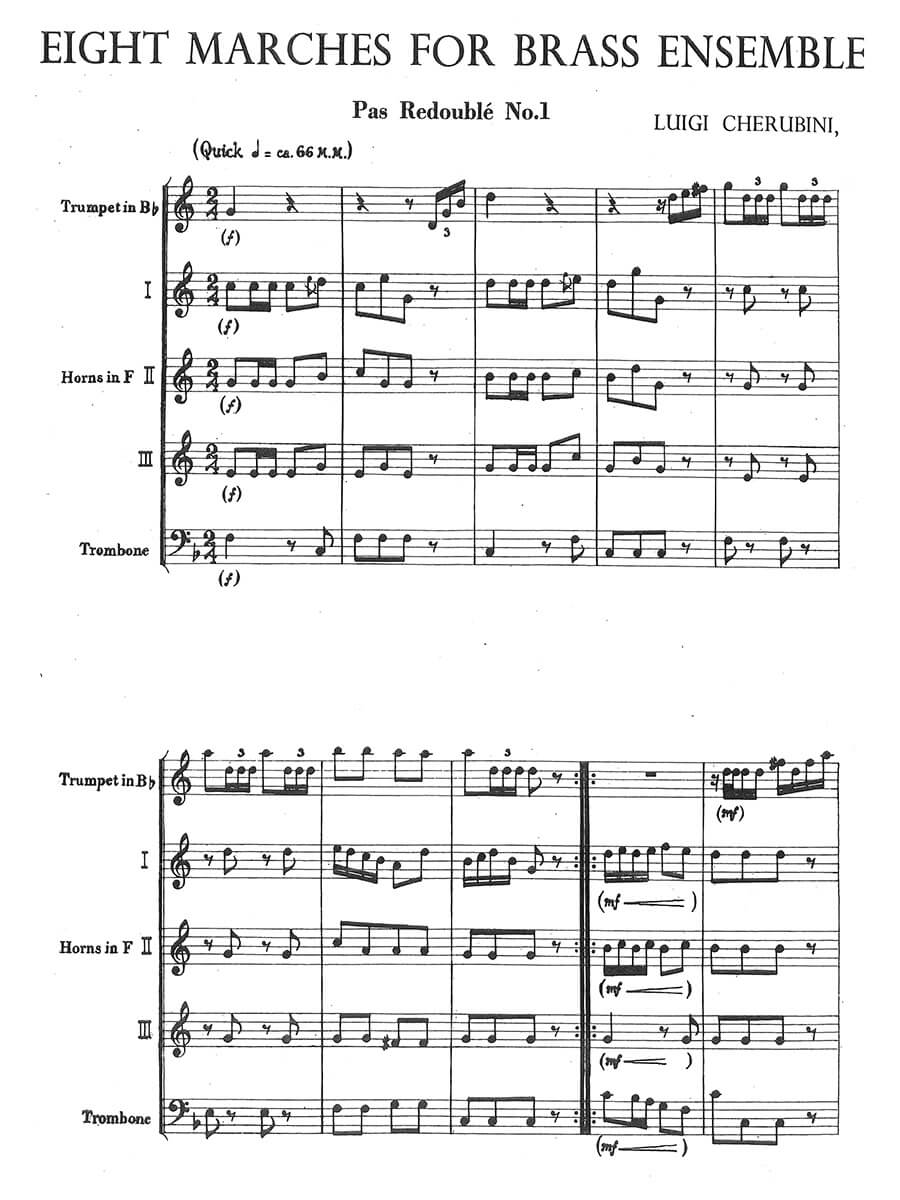Eight Marches for Brass Ensemble
Cherubini, Luigi
18,00 €
Preface
Luigi Cherubini – 8 Marches for Brass Ensemble
(b. Florence, 14 September 1760 — d. Paris, 15 March 1842)
Preface
Though lesser known today compared than his contemporaries, Luigi Cherubini was a dominant figure in Parisian music for half a century. A Florence-born composer, teacher, and conductor, Cherubini became a citizen of France in 1794 and served as the director of the Paris Conservatory starting in 1822. Cherubini’s career was marked by his interactions with the French government, and particularly, by his involvement with Napoleon.
After gaining his French citizenship, Cherubini was employed in 1795 as the teaching inspector of the Garde Nationale led by Bernard Sarrette, the founder of the Conservatoire Nationale de Musique. In this position, Cherubini composed a number of hymns, odes, and marches for political festivals and celebrations. Cherubini, in the following year, conducted the Corps de Musique at the anniversary of the beheading of Louis XVI (Hymn à la victoire).
Upon Napoleon’s rise to power in France, the leader began showing an interest in the “propaganda value of music”1. Cherubini, however, despite his popularity in Paris, was repeatedly ignored and not favored by the leader during his first years of power. It was recorded that Napoleon favored the lighter Italian composer Paisiello and described Cherubini’s music as being “noisy and complicated” and disliked it because he could not “make anything of it”.2
Cherubini’s travels to Vienna in 1805 were both a cause for celebration but also marked the beginning of his strained relationship with Napoleon. In Vienna, Cherubini directed his own pieces, met by invitation with Haydn, and made the acquaintance of Beethoven. He received a diploma and medal from the Conservatoire FROM Haydn with whom he had an affable relationship. Cherubini also attended the premiere of Beethoven’s Fidelio. The musical life in Vienna was brought to a halt, however, with Napoleon‘s conquest of the city shortly later. While in Vienna, Napoleon heard of Cherubini’s successes and directed Cherubini to organize and conduct concerts in his residences and then return to Paris.
Upon Cherubini’s return to Paris, the composer suffered a severe depression which halted his creative output completely from 1806 through most of 1808. Following this, Cherubini composed his opera, Pimmalione for the private entertainment of Napoleon and then was later asked by Napoleon to write music for his wedding to Marie-Louise of Austria in 1810 and then for the birth of their son in 1811.
Napoleon’s first fall from power occurred in late 1813 in the Battle of Leipzig by Austrian and Prussian allies. These allies would then occupy Paris in the spring of 1814 and force Napoleon into exile. At the request of the occupying garrison’s director, Colonel Von Witzleben, Six Pas Redoublés et deux Marches pour la musique du Régiment des Chasseurs de la Garde du Roi de Prusse was composed by Cherubini in May of 1814.Eight Marches for Brass Ensemble is a rather simple work and one of relatively few instrumental pieces written by Cherubini. The original instrumentation was most likely trumpette demilune (a crescent-shaped natural trumpet pitched in F that allows for hand-stopping), three natural horns in F, and serpent. The first horn part holds most of the melodic material throughout with the other two horns playing in either supportive, homophonic lines or in imitation with the first horn. The trombone line outlines the bass line and occasionally will play a more chromatic, melodic line which allows the first horn a chance to rest. The trumpet part is used primarily as an embellishment line. Its short arpeggiated motives are used as either punctuation to the melody or as rhythmic embellishment the melodic line and cadences.
The melodic figures in all parts are limited to the notes within the harmonic series for each of the instruments. There are a few exceptions where more chromatic passages and harmonies are present, but these are limited to the horn and trombone parts, requiring hand stopping and the use of the slide, respectfully) and are not present in the trumpet lines. Most of the harmonic language, therefore, focuses around the key of F major, C major, and d minor.
The forms of the marches are typical to the other instrumental music of Cherubini, most notably, his five string quartets. The pieces are primarily periodic and symmetrical. There is little development of the short themes that are presented. This is a deviation from the other instrumental works of the time where composers were developing short themes and ideas before contrasting with new ideas. Pas Redoublés numbers 1, 2, and 4 are in a sectional ternary form and 3, 5, and 6 are in rondo. The Marches are each in a sectional binary form.Sheri Fernandes, 2017
1 Margery Stomne Selden, “Napoleon and Cherubini,” Journal of the American Musicological Society, Vol. 8, No. 2 (Summer, 1955), pp. 110-115.
2 Augener, “Mars and Music”, The Monthly Musical Record, vol. 23, (December 1893), p.266-267.
Score Data
| Edition | Repertoire Explorer |
|---|---|
| Genre | Wind Orchestra |
| Performance Materials | available |
| Size | 210 x 297 mm |
| Printing | Reprint |
| Pages | 48 |
